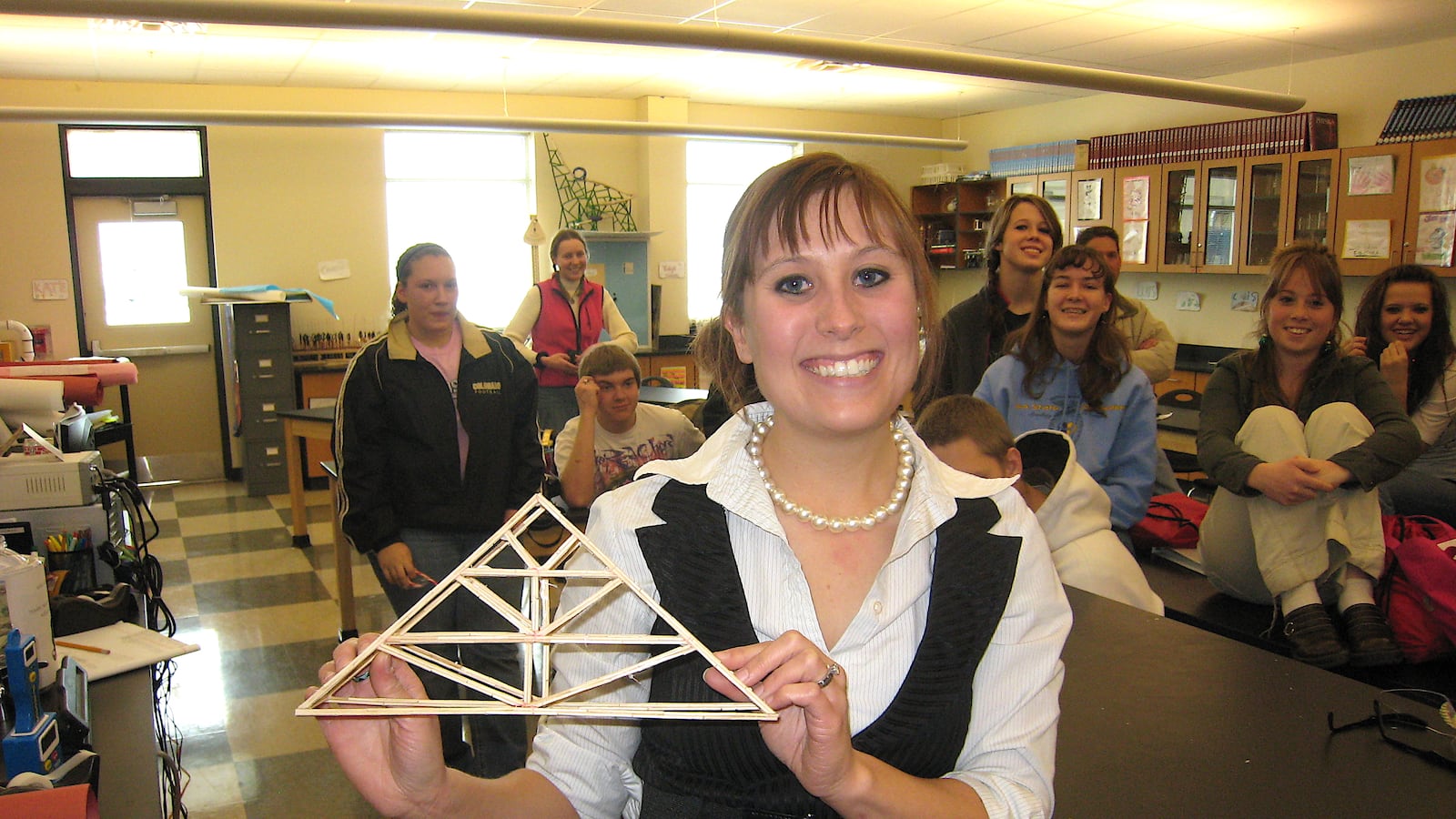Here, in a feature we call How I Teach, we ask educators who’ve been recognized for their work how they approach their jobs. You can see other pieces in this series here.
Shannon Wachowski once started a parent-teacher conference by sharing that she was concerned about the student’s lack of motivation. The boy’s mother quickly began adding criticisms of her own — alarming Wachowski enough that she started defending the teen.
It was then the student’s behavior began to make more sense to Wachowski, who teaches everything from ninth-grade earth science to college-level chemistry at Platte Valley High School in northeastern Colorado. She realized that school, not home, was the boy’s safe place.
Wachowski is one of 20 educators who were selected to serve on the state Commissioner’s Teacher Cabinet. The group provides input to officials at the Colorado Department of Education.
She talked to Chalkbeat about how she uses parent conferences and classwork to learn students’ stories, why making Rube Goldberg contraptions boosts kids’ confidence, and what happens when she raises her hand in the middle of class.
This interview has been condensed and lightly edited.
Why did you become a teacher?
Originally a practicing chemical engineer, I became a teacher because I wanted a more fulfilling career. I had tutored chemistry in college and really enjoyed it.
What does your classroom look like?
Because my students work in teams 90 percent of the time, my tables are arranged so that students can sit in groups of four. I wrote a grant last summer for standing desks so each two person desk raises up and down. They are convenient for labs or when students need a change of scenery. My walls contain student-made license plates (an activity I do on the first day of school) and other student work from class, including various Chemistry Cat memes!

Fill in the blank. I couldn’t teach without my ________. Why?
My heart. Initially I became a teacher because I loved my content. I soon realized however, that while content is important, developing relationships with students is paramount. No learning will happen if positive relationships are not established first. When I am frustrated with student behavior, I try to put myself in their place and respond in a caring and compassionate manner.
What is one of your favorite lessons to teach?
One of my favorite lessons is when my students build Rube Goldberg devices. It gets somewhat chaotic because they are working in teams and materials are everywhere, but every single student is engaged. In the end, they can apply what they know about energy to design a multi-step contraption. I have seen very low-confidence students excel at this activity, and it is very rewarding to see them experience success in a science class.
How do you get your class’s attention if students are talking or off task?
One strategy I’ve recently started using came from my experience leading professional development for other teachers. I will be somewhere in the middle of the room (usually not the front) and raise my hand. When students see me raise my hand, they will raise theirs and pause their conversation. Then other students see those students and raise their hand, etc. Once everyone is quiet, then I’ll make my announcement. Like all other strategies, I need to practice being consistent with it.
How do you get to know your students and build relationships with them? What questions do you ask or what actions do you take?
I always plan the first couple of days for “get to know you” activities. My students design their own paper license plates using whatever letters, numbers, or design they would like. They then have 30 seconds to talk about their license plates.
I noticed that in some of my more challenging classes I needed a way to better connect with my students. At the beginning of most class periods I share some sort of funny story about what happened to me the evening prior — for some reason, I am never short of these stories — or a picture of my dog, or my latest climbing adventure. Sharing this information does not take long and eventually, students will ask if I have a story to share if I haven’t done so in a while. This also leads to them sharing stories with me, and finding that we may have more in common than we think.
Tell us about a memorable time-good or bad-when contact with a student’s family changed your perspective or approach.
At parent-teacher conferences one year I had a parent come in with their student. This student was not the most motivated individual — not disrespectful, just did not seem to want to do anything with his time. As I was explaining this to his parent, the parent started talking very negatively to and about the student, so much so that I found myself trying to defend the student and bring up positive qualities about his character. This interaction helped me to understand some of the student’s behavior in class, as well as realize that for some students, school is their safe place. There are often lots of reasons for a student’s behavior that I may not be aware of, which is why it is important to get to know each student and their situation as best as possible.
What are you reading for enjoyment?
When I have time outside of school, one of the things I enjoy doing is throwing pottery. I am currently reading “Science for Potters” by Linda Bloomfield. It combines my love of science and art into one book.
What is the best advice you ever received?
Since I teach a variety of levels, I often have one class that challenges my classroom management skills. This can be frustrating as I am the type of person that would like to achieve perfection in every circumstance. When I have a discipline issue in my class, I often see it as a personal failure. My husband often reminds me that “You can’t control other people’s behavior, you can only control your response to it.”

